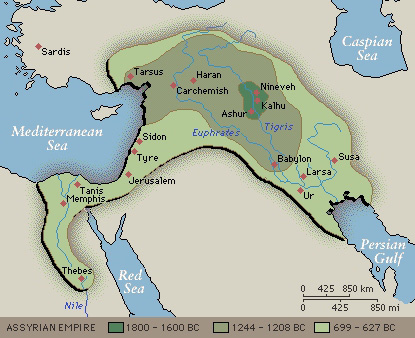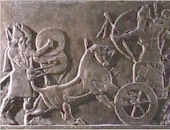Telefon: 08‑5195 5488
E-post: info@visarkiv.se
Besöksadr: Torsg. 19, Stockholm
- Virtual Assyria
- Preface
- The Assyrians as an example
- Assyria – your land in Cyber Space
- Cyberland – Music, Nationalism & the Internet
- With music as a boundary marker
- Christians from the Middle East
- The liturgy of the Syrian churches
- A visit to a musical rebel
- Assyrian music on the Internet
- Expressive specialists
- References
Assyria – your land in Cyber Space
Where is Assyria? When we talk about nations we usually think in terms of geographical regions. But you won't find the country of Assyria in any present-day atlases – you might find it in a historical atlas of ancient Middle Eastern high cultures.
History books tell us that the Assyrian Empire existed between ca. 2000 B. C. and 612 B. C. This means that Assyria ceased to exist more than 2,600 years ago. Assyria was one of the most powerful empires of that period, with a nucleus which stretched from the Nile in the west to the region between the Persian Gulf and the Caspian Sea in the east.

Historic map of the Assyrian Empire
Source: Assyrian Picture Archive
According to Assyrian historical writings, the Assyrian Empire was established in 4749 B. C. by a Semitic folk group which captured the region between the rivers Tigris and Euphrates. Present-day Assyrians/Syrians who speak Aramaic use the name Beth Nahrain, "The Two-River Land" for the Assyrian Empire. The Greeks used the name Mesopotamia for the Assyrians' land, which means "The land between the rivers".
Today some Assyrians want to use an alternative calendar, which starts from the foundation of the first Assyrian Empire. At the time of writing, the present year (1997) is therefore the year 6747. New Year's Day falls on the 1st April and is celebrated by Assyrians all over the world.
Originating in the town Assur (Ashur, with East Assyrian spelling, on the map above) on the Tigris in what is now Iraq, the Assyrian high culture gradually expanded with highly developed commerce, architecture and literature. The Assyrians used cuneiform script, inscribed on clay slates and other durable material, which is why we have so many written sources documenting commerce in ancient Assyrian times (2000-1750 B. C. ). In the Assyrian Empire dialects from the Akkadian language groups were spoken. The written languages were Babylonian and Sumerian.

The Assyrian king Ashur II
Source: Assyrian Picture Archive
View a complete list of Assyrian kings (presented by Assyria Online)
Nineveh (the capital city at that time) was captured by the Babylonians and Medes in 612 B. C. and the former great power Assyria became part of the Neo-Babylonian Empire. The Akkadian languages were replaced by another Semitic language, namely Aramaic, which is still spoken in this region today.
Assyria as a political power was dissolved, the language disappeared and was replaced by a new language, the old religion with Ashur as the highest god was superseded by the Christian and Muslim faiths – Assyria appeared to have been irrevocably wiped out.
However, in the 1900s – and above all during the last twenty years – a new Assyria has come into being; not as a geographically defined nation (never before have the Assyrians been scattered all over the world to such an extent as they are now), but as a virtual reality – a Cyberland – a community which exists through societies and networks throughout the world.
Assyrians/Syrians in Sweden
The migration of Christians from the Middle East to the Western world has been going on for about a century. At the turn of the century groups of East Assyrians migrated to the United States, as well as some groups of Syrian Orthodox Christians, albeit far fewer in number. During the 1950s West Germany started to import a massive influx of manpower from Turkey. In addition to ethnic Turks, these groups of immigrants also included a number of Kurds and Christians.
The first Assyrians/Syrians to arrive in Sweden were part of a group of ca. 200 Christians from Lebanon who were allowed into the country as the result of a request from the World Council of Churches and the UN High Commissioner for Refugees. The group was gradually spread out over about fifty places in Sweden. However, Södertälje (20 miles south of Stockholm) soon became a kind of centre for the Assyrian/Syrian immigrants. Between 1972 and 1976 four more groups of refugees from Lebanon were admitted. A certain number of family reunions were also permitted during this period. In 1970 the first Syrian Orthodox congregation was formed in Södertälje.
Between 1974 and 1978 the migration of Christians from Turkey increased enormously. One reason for this was the conflict in Cyprus which raised the level of tension between Muslims and Christians in Turkey. The increased immigration into Sweden was also due to the fact that West Germany had stopped immigration from the Middle East and Turkey and had also sent guest workers back to their homelands. Many Assyrian/Syrians then chose to apply to come to Sweden from Germany. In 1978 it was estimated that there were ca. 7,000 Assyrians living in Sweden.
During the 1980s and early 1990s immigration was dominated by Assyrians/Syrians from Syria and Lebanon. In the Swedish Immigration Board's statistics these Christian immigrants who mainly come from Lebanon are classed as stateless citizens. During the years 1989 to 1990 this group numbered nearly 5,000 people.
Today, in 1997, it is estimated that there are ca. 50,000 Assyrians/Syrians living in Sweden. This number includes both first generation and second generation immigrants but is very difficult to determine exactly. Population figures produced by Statistics, Sweden (SCB) are primarily based on nationality and are not easily applicable to Assyrians/Syrians. In SCB's statistics the Assyrian/Syrian immigrants are an unidentifiable part of the total group of immigrants from Turkey, Syria, Iraq, Lebanon and Iran.
Organisations
The Assyrian/Syrian group in Sweden is represented by two national federations:
The Assyrian National Federation which was formed in 1977, and the Syrian National Federation which was formed in 1978. Both national federations have local organisations throughout Sweden. In 1996 ca. 8,300 Assyrians were affiliated to the Assyrian National Federation and ca. 12,000 Syrians were affiliated to the Syrian National Federation. Both federations issue monthly magazines; the Assyrian National Federation's Hujådå has a circulation of 2,000 copies, while Bahro Suryoyo, which is issued by the Syrian National Federation, has a circulation of 1,300 copies.
The Immigrant Department at the Swedish Broadcasting Corporation broadcasts news and cultural features in Turoyo in the programme Qolo.
